EASTHAM — In the hierarchy of Cape Cod shellfish, the story of the clam is often forgotten in favor of the glamorous Wellfleet oyster. Across the country and the world, menus boast oysters hailing from the Outer Cape. Why not give the clam its moment in the sun?
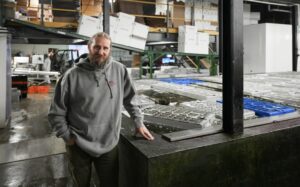
Millions of clams are born and raised in Barnstable County each year, with Eastham and Wellfleet serving as major hubs of the industry. The hard-shelled Mercenaria mercenaria, better known in these parts as the quahog, is the main farmed clam. It is the most popular culinary clam of the Atlantic coast, yet few know where it comes from and how it gets to their plates.
The quahog is by no means unassuming. It doesn’t typically bear a pearl like some other more ostentatious shellfish, but to the Wampanoag, the beauty of its violet-streaked interior merited its use as currency, called wampum. It is used in swanky dishes like Clams Casino, baked on the half-shell with breadcrumbs and bacon, a recipe reportedly created at the Little Casino in Rhode Island in 1917. The smallest of the quahogs is called the littleneck; next up is the topneck; then the cherrystone. The largest are called quahogs — they keep the family name.
The lives of most quahogs farmed on the Cape begin at a hatchery in Dennis — the Aquacultural Research Corp. (A.R.C.), founded in 1960. In their youngest form, seed clams are minuscule, on par with a grain of rice. The hatchery helped kickstart larger-scale clam farming on the Cape in the 1980s by nurturing larval-stage clams into spat — seed clams that could be sold to farmers — according to Paul Wittenstein, the hatchery’s general manager.
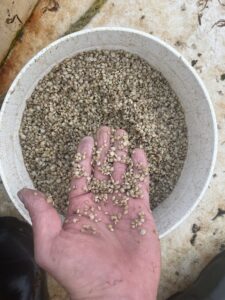
The seed at A.R.C. comes from a long genetic line, beginning with wild clams brought to the lab 50 years ago, according to Wittenstein. The company has kept track of subsequent generations’ growth and survival to ensure the line’s longevity.
In late November, the broodstock — mature clams used for breeding — are brought into the nursery and placed in tanks of seawater that are slowly warmed to 70 degrees over the course of 8 to 10 weeks, imitating nature’s spring warming pattern.
Next, the broodstock goes into buckets, where it gets a “heat shock” of 8 more degrees, which “mimics the tides rolling over the flats on a beautiful day in July,” Wittenstein said. This induces the clams to release their sperm and eggs, some of which will become larvae. The larvae are moved to culture tanks where, over a couple of months, they grow, feeding on algae grown onsite.
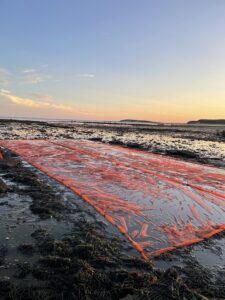
Finally, the seed clams are moved to A.R.C.-owned upwellers — incubators that pump seawater — at nursery sites in rivers, ponds, and creeks in Chatham, Harwich, and Dennis, just in time to align with summer. After a final fattening there, the seed clams are ready to be sold.
The hatchery sells its seed clams to hundreds of farmers, 75 percent of whom are on the Cape, though Wittenstein said they have some customers as far south as Alabama. When the tiny clam seeds leave the hatchery, they go for around $40 per thousand — 3 to 4 cents apiece.
On the Flats in Wellfleet
David Ziemba gets most of his spat from A.R.C. Ziemba embarks alone across Wellfleet Harbor as the sun rises to visit his deep-water grants in an area known as Egg Island. After a stint doing offshore fishing, Ziemba began working on his family’s two-acre grant in 1995, growing both quahogs and oysters.
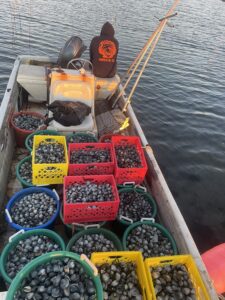
Wellfleet offers a distinctive site for growing clams, Ziemba said. Between the balance of fresh and salt water, the varieties of mud and sand, and the depth of different grants, he said that Wellfleet shellfish have both breadth and their own flavor that’s “very briny and yet sweet.”
The process of clam farming is “not really that exciting,” said Ziemba. But it keeps him busy for nine months of the year, from the beginning of March through the end of December, when the water temperature drops below 45° F and the clams go dormant.
In the off season, he works on his gear, then takes off for Florida when it gets too cold.
In the spring, Ziemba prepares the flats, removing crabs, moon snails, and debris. Then he seeds the clams, scattering them on top of the sand, and covers them with a net to protect them from predators until they are large enough to burrow deep and stay put. The clams take three years to get to harvest size, so he works in sections, each with clams at different stages.
During the growing season Ziemba harvests three mornings a week, dragging the bottom with a Virginia Harvester rake made in Harwich at the R.A. Ribb Co. He spends the rest of his time packing and unloading clams. He said that his typical order is 12,000 clams a day.
In Eastham, Sorting and Shipping
Ziemba takes his harvest to the Wellfleet Shellfish Co. most mornings. There, owner Alex Hay and his crew sort through and label the clams along with thousands of other pieces of shellfish each day.

In spite of its name, the facility is on Holmes Road in Eastham, between a welding shop and a coffee roaster. In the main area of the warehouse, huge tubs of lobsters line the walls, and every surface is drenched in seawater. Reggae music plays from speakers as about a dozen workers sort and count shellfish that are then flung into net bags by a machine.
The wholesaler’s day starts at about 6 a.m. with a crew of 12 or so sorting and weighing shellfish as it arrives. It’s a “first in, first out” operation, Hay said. “We’re not an aquarium; generally, 24 hours after the product is landed, it’s sold.” The last truck leaves Eastham at about 2 a.m., headed mostly to other suppliers.
The plant is not a beautiful place, but it is cold and clean. These are highly regulated conditions, said Hay, designed to maintain the quality of the shellfish. At any given time, the facility can hold about 35,000 pounds of lobster and another 10,000 to 15,000 pounds of shellfish, about two thirds of it oysters and the rest quahogs. The operation runs 52 weeks a year and sells up to 5 million clams in a good year. Quahogs wholesaling at an average price of 25 cents each — the market price changes daily.
More than half of the company’s sales are during the summer, but several years ago Hay made the decision to run it year-round. “I made the switch to eliminate the big swing and keep this place going,” he said, but it can be “a bit like trying to grow tomatoes in January.”
Although Hay made his name as a fishmonger, he said that now “my job is 2 percent seafood, 98 percent logistics.” The plant began as part of Mac’s Seafood in 2012, and Alex bought his brother, Mac, out of the wholesale operation in 2020. Today, Hay said, the company is probably one of the top 10 sellers in the country in terms of volume — a reflection of the productivity of local growers. “We always say that the fishermen and the farmers we work with are more important than our customers,” he said. “Without them, we are nothing.”
The End of the Chain
After the shellfish leaves Eastham, it travels as nearby as Boston and as far away as Singapore. The quahogs often make a stop at Foley Fish, a distributor with operations in Boston and New Bedford. Foley sorts the clams and further distributes them to restaurants across the country and the world.
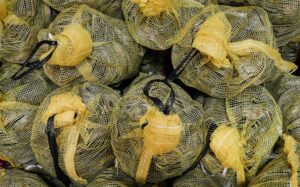
At Davio’s Italian Steakhouse, a high-end establishment in Boston’s Back Bay, quahogs trucked from Eastham end up in clam chowder with pancetta, and littlenecks are served chilled on a seafood tower for $4.50 each. And since the steakhouse has a location at Logan Airport, clams from here end up in bellies across the world every day.
Some are shipped uneaten, of course. “They love them in the Netherlands and in France,” Hay said.



